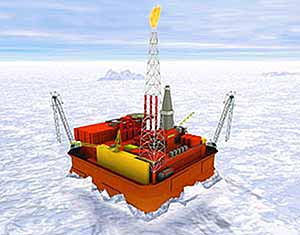07.06.2009
June 1, 2009 (the date of publication in Russian)
Maxim Kalashnikov
PLAYING WITH FIRE IN THE ARCTIC
Norway and its Western allies challenge the Russians in the basin of the Arctic Ocean
 The first knot of the possible clash between Russia and the West lies in the Arctic. UN Commission on the Limits of the Continental Shelf admitted the Norway's claim for the part of the shelf in the Barents Sea (making up the area of 235,000 square kilometers), which breaks into the Soviet sector of the Arctic, founded in 1926. And breaks into 175,000 square kilometers of our territory at that.
The first knot of the possible clash between Russia and the West lies in the Arctic. UN Commission on the Limits of the Continental Shelf admitted the Norway's claim for the part of the shelf in the Barents Sea (making up the area of 235,000 square kilometers), which breaks into the Soviet sector of the Arctic, founded in 1926. And breaks into 175,000 square kilometers of our territory at that.
Thereby, the first hotbed of possible clash of interests and probably even of war is created. What's next?
Our former prophecies seem to come true (read the article†POLAR TERRITORIES OF RUSSIA ARE UNDER THREAT [Russian language version only. – Editor]). Before Russia had time to submit for consideration the grounds for its right for the Soviet sector in the Arctic Ocean, Norway left us behind. Moreover, we do not possess the technology of deep-water drilling giving us the ability to prove that underwater Lomonosov Ridge is the continuation of Siberia. Norwegians, however, have such drilling platforms. Another prophecy that we've made also came true: UN "plays into the hand" of our opponents, rather than to us. And in this case shallow water Ц alleged continuation of Spitsbergen archipelago Ц has been declared a part of Norwegian territory. It is also the location of the "crown jewel" Ц so called "Fedyuninsky elevation", huge deposit of oil and gas.
Situation in the Barents Sea is somewhat easier: its bottom is pretty well explored by Russians. With the same degree of success we may prove that the questionable area of the sea floor is a continuation of the shelf of Kola Peninsula and Novaya Zemlya archipelago, or the continuation of the shelf of Franz-Josef Islands. But still our country is a little late with such actions. We reap the fruits of the over cautiousness of Soviet leadership. Arcticmorneftegasrazvedka has been already conducting the exploration work at the questionable area in 1970s, but in 1982, this work was brought to a close because of the unwillingness to strain the relations with Oslo.
Now it's clear, that these concessions were interpreted as a sign of weakness. Norwegians increased the pressure after the collapse of Soviet Union, believing that the era of Russian dominance in the Arctic was over. Moscow is challenged. Shallow and non-freezing Barents Sea is an ideal place for the gas-field development.
†
WHAT SHOULD THE RUSSIANS DO?
First of all we have to start the long (probably a few years) litigation with the Norwegians, disputing their rights for the indicated area of the sea floor. Since we're capable of these researches, resuming the exploration work would allow Moscow to offer the international organizations its grounds for the rights for the disputable area. We have to appeal to the fact that the border of this area established by Stalin in 1926 (and slightly adjusted in 1935) was admitted by all of countries of the Arctic basin for decades. We have to lay the stress on the limitedness of sovereignty of the Norway at the Spitsbergen, stated by Paris Treaty in 1920 (the disputable area is an alleged continuation of the shelf of Spitsbergen). Exhausting the opponent in the endless negotiations Ц that's the tactics we need.
At the same time, Moscow should stick to the hard-line policy: "If you want to develop the Arctic gas- and oil-fields Ц you'd have to do it in cooperation with Russia. Soviet prime-minister Nikolay Ryzhkov made Norway this offer as far back as 1988. Otherwise we won't let you to drill here".
We desperately need a new, innovative development program for the Northern fleet. We need military aquanauts, military ram-wing machines, and navy missile-carrying aviation. Perhaps, we need to create the frontline base of aviation at the Franz-Josef Land. By the way, it was already deployed here at the time of Stalin's rule Ц it was an airfield for the air expeditions to the North Pole. We should also remember that this time nobody would ignore our potential weaknesses. Weakness in this matter is a first step towards the loss of sovereignty of a promising gas- and oil-field shelf and also the strategically important sea area. Actually, this area is a convenient position for the deployment of assault groups of NATO submarines Ц means of delivery for the strategic cruise missiles.
We should not lose heart because of some UN decisions. We should pursue our own goals and interests. As the experience shows us, those who were firm, always got what they wanted. After all Soviet Union did gained its point in 1926Ц1935 here even without a strong navy!
Number of shows: 2253
rating:
3.3
 ENG
ENG 

 ENG
ENG 
